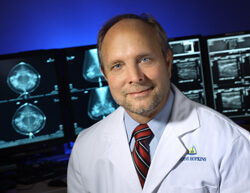Johns Hopkins Surgery
February 1, 2014

Who's at Risk for Genetic Inheritance of Breast Cancer?
Patients with gene mutations in BRCA1 or BRCA2 have up to an 80 percent likelihood of getting breast cancer and up to a 60 percent chance of developing ovarian cancer. "Genetic testing helps us determine which members of a family are at increased risk for cancer and which aren't," says Euhus. Those who are found not to be at increased risk can return to life as usual. When the mutations are discovered, however-via lab analysis of a DNA sample from either blood or saliva-four types of intervention are available.
Treatments for Those With Genetic Risk of Breast Cancer
"The first thing that we talk about is lifestyle," Euhus says. "There's good evidence that staying physically active and avoiding weight gain in middle age reduces the risk of developing cancer."
Enhanced surveillance is also recommended. Physicians will see patients every six months, alternating mammograms with MRI scans. Though MRIs are more expensive, they're also more sensitive, and they're covered by insurance for patients with mutations. "That's another good reason to get genetic screening," Euhus says.
A next line of defense is a chemopreventive drug, Tamoxifen, which lowers the risk of breast cancer by about 50 percent. "It's a good idea for BRCA2 carriers, Euhus says, "and probably a good idea for BRCA1 as well."
Finally, prophylactic surgical options include removal of the ovaries, which most women with known mutations will do by age 40. This offers the dual advantage of bringing down the risk of breast cancer by as much as 60 percent. And, with improvements in surgical techniques, mastectomies are an increasingly viable and appealing route for patients. "We do skin- and nipple-sparing mastectomies, and beautiful reconstructions," Euhus says. "It's not mutilating like it used to be."
To refer a patient: 443-997-8282
